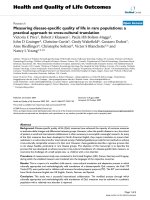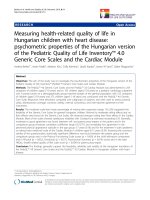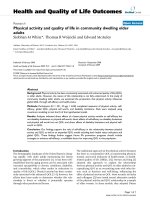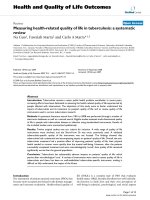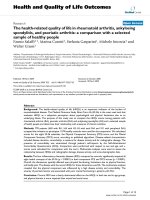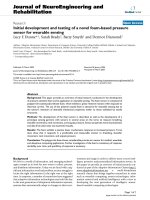báo cáo hóa học: " Impaired sleep affects quality of life in children during maintenance treatment for acute lymphoblastic leukemia: an exploratory study" pdf
Bạn đang xem bản rút gọn của tài liệu. Xem và tải ngay bản đầy đủ của tài liệu tại đây (252.55 KB, 7 trang )
RESEARC H Open Access
Impaired sleep affects quality of life in children
during maintenance treatment for acute
lymphoblastic leukemia: an exploratory study
Raphaële RL van Litsenburg
1*
, Jaap Huisman
2
, Peter M Hoogerbrugge
3
, R Maarten Egeler
4
, Gertjan JL Kaspers
5
and Reinoud JBJ Gemke
1
Abstract
Background: With the increase of pediatric cancer survival rates, late effects and quality of life (QoL) have received
more attention. Disturbed sleep in pediatric cancer is a common clinical observation, but research on this subject
is sparse. In genera l, sleep problems can lead to significant morbidity and are associated with impaired QoL.
Information on sleep is essential to develop interventions to improve QoL.
Methods: Children (2-18 years) with acute lymphoblastic leukemia (ALL) were eligible for this multi-center study.
The Children’s Sleep Habits Questionnaire (CSHQ), Child Health Questionnaire (CHQ) and Pediatric Quality of Life
Inventory 3.0™ Acute Cancer Version (PedsQL) were used to assess sleep and QoL halfway through maintenance
therapy. Sleep and QoL were measured during and after dexamethasone treatment (on-dex and off-dex).
Results: Seventeen children participated (age 6.7 ± 3.3 years, 44% boys). Children with ALL had more sleep
problems and a lower QoL compared to the norm. There were no differences on-dex and off-dex. Pain (r = -0.6; p
= 0.029) and worry (r = -0.5; p = 0.034) showed a moderate negative association with sleep. Reduced overall QoL
was moderately associated with impaired over all sleep (r = -0.6; p = 0.014) and more problems with sleep anxiety
(r = -0.8; p = 0.003), sleep onset delay (r = -0.5; p = 0.037), daytime sleepiness (r = -0.5; p = 0.044) and night
wakenings (r = -0.6; p = 0.017).
Conclusion: QoL is impaired in children during cancer treatment. The results of this study suggest that impaired
sleep may be a contributing determinant. Consequently, enhanced counseling and treatment of sleep problems
might improve QoL. It is important to conduct more extensive studies to confirm these findings and provide more
detailed information on the relationship between sleep and QoL, and on factors affecting sleep in pediatric ALL
and in children with cancer in general.
Background
Surv ival rates for childhood cancer are increasing, espe-
cially for the most common type of pediatric cancer,
acute lymph oblastic leukemia (ALL). Over the past dec-
ades survival for ALL has reached 80-85% [1]. The
improved survival rates have led to more attention to
other outcomes, such as quality of life (QoL), fatigue
and to a lesser extent, sleep. In clinical practice it seems
that sleep related problems are not uncommon during
ALL treatment, but research on this subject is sparse.
Sleep disorders in children can lead to significant
behavioral and cognitive morb idit ies. The prevalence of
sleep problems in children in the general population is
up to 30% [2,3]. Gender and age influence sleep [3-5],
and some sleep problems are more common during cer-
tain stages of child development, such as night wakings
during infancy [6] and sleep onset delay in older chil-
dren [3]. Children with sleep difficulties experience
higher rates of behavioral problems, depression, anxiety
in adulthoo d, and impaired cognitive function and emo-
tional development [6-11]. Sleep problems are more
* Correspondence:
1
Department of pediatrics, VU University Medical Center, Amsterdam,
Netherlands
Full list of author information is available at the end of the article
van Litsenburg et al. Health and Quality of Life Outcomes 2011, 9:25
/>© 2011 van Litsenburg et al; licensee BioMed Central Ltd. This is an Open Access article distrib uted under the terms of the Creative
Commons Attribution Licen se ( which perm its unrestricted use, distribution, and
reprodu ction in any mediu m, provided the original work is properly cited.
common in certain medical conditions, such as chronic
pain, attention deficit hyperactivity disorder, and autism
[12-14]. Information on sleep in cancer patients is
limited. Reported prevalence of sleep problems in adult
cancer patients varies greatly but seems higher than in
health y people [15,16]. Mulrooney et al.[17] reported on
sleep in a large pediatric cancer survivor cohort using a
sleep questionnaire, and found a lower sleep quality
compared to siblings, although the authors argue that
the differences might not be clinically important. During
ALL treatment children seem to experience more sleep
problems, and the use of c orticosteroids negat ively
affects sleep [18,19]. Hinds et al.[4] performed actigra-
phy in children with ALL and found that dexametha-
sone alters sleep. During dexamethasone treatment
duration of sleep was increased and there was an
incre ase in nighttime awakenings, restless sleep and nap
time.
An associat ion between poor quality of sleep and
impaired health-related quality of life and well being has
been found in several populations, such as children with
chronic pain and survivors of childhood cancer
[13,17,20,21]. To our knowledge, the relationship
between sleep an d QoL during ALL treatment has not
yet been studied. Insight in the relationship between
sleep and QoL may help develop interventions in order
to improve QoL during and after childhood ALL treat-
ment. Therefore the main objective of this study was to
assess sleep, QoL, and the relationship between sleep
and QoL, in children duri ng maintenance treatment for
ALL . We hypothesized that impair ed sleep is associated
with impaired QoL, and that sleep and QoL are nega-
tively affected by dexamethasone.
Methods
Patients
Eligible patients were between two and eighteen years of
age, and were receiving ALL maintenance therapy
according to the Dutch Childhood Oncology Group
ALL10 medium risk protocol at one of the three partici-
pating tertiary care hospitals (VU University Medical
Center, Amsterdam; Leiden University Medical Cent er,
Leiden; St Radboud University Medical Center, Nijme-
gen). Children were recruited from August 2006 till
October 2007 at the VU University Medical Center
Amsterdam, at the Leiden University Medical Center
from February till August 2007, and at the Radboud
University Medical Center Nijmegen from January till
July 2007. Eligibility was restricted to one risk group in
order to keep treatment variables similar, and the
medium-risk (MR) group was chosen because it is the
largest category. Participants had to be Dutch speaking
and provide informed consent. Children with pre-
existent serious morbidity that was thought to influence
sleep and QoL, such as a psychiatric or neurological
disorder, were excluded. The study was approved by the
institutional review boards.
Sleep was assessed halfway through maintenance
therapy. Because the MR maintenance protocol includes
cycli c corticosteroids (6 mg/m2 dexamethasone per day,
every three weeks for five consecutive days), measure-
ments were done twice to assess the influence of
dexamethasone: once at the end of a dexamethasone
period (on-dex) and the second time at the end of a
dexamethasone free period (off-dex) five weeks later.
Questionnaires were sent to the participant’s home with
instructions and a stamped return envelop. The sample
size was based on QoL differences on-dex and off-dex
as found before in Dutch children with ALL [22]. Using
mean and SD scores of the physical summary score of
the Child Health Questionnaire, a sample size of 19 was
required in order to have 80% power to detect an effect
size of 0.6 at a 5% significance level (one sided test).
Questionnaires
The Children’s Sleep Habits Questionnaire (CSHQ) is a
one-week recall, 33 item parental questionnaire th at was
developed as a sleep screening tool for school-aged chil-
dren and has been shown to be a useful screening tool
in younger children as well [23,24]. Both the original
and the Dutch version of the CSHQ have adequate psy-
chometric properties [23,25]. The frequency of sleep
behavior is rated for the most recent “typical” week on a
three point Likert scale, with the response options
usually (5 to 7 times per week), sometimes (2 to 4 times
per week) and rarely (0 to 1 time per week). A higher
score indicates more sleep disturbances. Information on
habitual bedtime, morning wake-up time and sleep
duration was collected additionally. The CSHQ allows
for a total score over 33 items and subscales scores on a
number of key sleep domains: bedtime resistance
(6 items), sleep-onset delay (1 item), sleep duration
(3 items), sleep anxiety (4 items), night wakening
(3 items), parasomnias (7 items), sleep-disordered
breathing (3 items) and daytime sleepiness (8 items).
The Dutch version of the Child Health Questionnaire
50 items parent form (CHQ) is a generic QoL assess-
ment tool and has shown good reliability and validity
[26,27]. The CHQ has been used in several pediatric
oncology studies [22,28,29]. This instrument covers the
physical, emotional and social well-being of children and
allows for two summary scores (physical and psychoso-
cial). Items are scored using a four to six point Likert
scale and converted to a 0 to 100 point continuum, with
higher scores indicating better QoL. The original refer-
ence period of the CHQ (four weeks) was adjusted to
suit the CSHQ r ecall period (one week). Dutch popula-
tion norms are available and allow for a comparison
van Litsenburg et al. Health and Quality of Life Outcomes 2011, 9:25
/>Page 2 of 7
with the Dutch healthy population [27]. Certain
questions, i.e. “ My child seems to be less healthy than
other children I know” were felt not to be appropriate
during ALL maintenance treatment because of the repe-
titive setup of the assessments. For these questions
(number 1 and 8), mean scores as found in a previous
study in Dutch children halfway ALL maintenance were
imputed [22]. The CHQ was designed for children five
years and up. Although the Infant and Toddler Quality
of Life Questionnaire would have been more appropriate
for the few younger children (n = 3) in our study sample
[30], at the time of the design of our study, no validated
Dutch version and norms were available.
The Pediatric Quality o f Life Inventory 3.0™ Acute
Cancer Version (PedsQL) is a reliable and valid cancer
specific questionnaire [31]. It has frequently been used
in pediatric oncology studies [22,32-34] and includes
subscales with age-specific questions for determining
problems in relevant areas during cancer treatment such
as pain, nausea, treatment and procedural anxiety,
worry, cognitive prob lems, perceived physical appear-
ance and communi cation. Items are scored using a four
point Likert scale and reflect on the past week. Higher
scores indicate better QoL.
Analysis
The Statistical Pack age for Soc ial Sciences for Macin-
tosh vers ion 18.0 was used for all data analyses . For the
description of demographic variables and questionnaire
scores, medium and inter quartile range (IQR), and
mean and standard deviation (SD) scores were calcu-
lated. To allow for age-specific differences in sleep,
three groups were identified: <5 year s, 5-7 years, and >7
years. Differences between Dutch CSHQ norm scores
and ALL scores were assessed using Mann-Whitney
U tests. CHQ differences with Dutch population norms
were calculated using one-sample t-tests. On and off
dexamethasone scores were assessed using Wilcoxon
signed ranks tests. Co rrelations between QoL and sleep
were calculated using Spearman’s correlations. For this
purpose individual sleep scores were corrected for age-
specific norms. Correlations betw een 0.2 and <0.5 were
considered small, between ≥0.5 and <0.8 moderate, and
≥0.8 were considered strong. Moderate or strong signifi-
cant correlations were considered to potentially be clini-
cally relevant and are reported in this study. Significance
level was set at two-sided p < 0.05 for all analyses.
Results
Demographics
Twenty-one children and their parents were eligible and
were invited to participate. Nineteen provided written
informed consent, one parent thought the study burden
was too high and declined participation, reasons for not
participating are unknown for the another child. No
demographic information was available on these
children. Questionnaires were not returned for one
child (a 10 year old male), and one questionnaire was
not filled out completely, so in total seventeen children
could be analyzed. Mean age at diagnosis was 6.7 years
(SD 3.3), 44% were boys.
Sleep
There appeared to be more sleep problems in children
with ALL compared to healthy children. Significant
differences were found for bedtime resistance (p =
0.020), sleep anxiety (p = 0.016) and night wakening
(p = 0.024). Children with ALL had fewer problems
with sleep onset delay (p = 0.024). In the youngest age
group (under five years, n = 6) those with ALL scored
significantly higher on the CSHQ total score (p =
0.034), and also had more problems with sleep anxiety
(p = 0.003), night wakening (p = 0.047) and parasomnias
(p = 0.037). In the middle age group (five to seven years,
n = 6) children with ALL scored significantly higher for
bedtime resistance (p = 0.025). There were no signifi-
cant differences in the oldest age group (n = 5). Results
are shown in table 1. Sleep did not differ between
on-dex and off-dex measurements, except for the sleep
onset delay subscale for which the off-dex score was sig-
nificantly higher, indicating more problems (p = 0.02).
In the youngest age group, children with ALL had a
median sleep duration that was 30 minutes longer than
the sleep duration in healthy children; this was a signifi-
cant difference (p = 0.042). There were no other differ-
ences in sleep times. Sleep times on-dex and off-dex
were not significantly different.
Quality of Life
QoL (both on-dex and off-dex) was lower in ALL
compared to Dutch CHQ population norms. This was
significant for all scales except f or family cohesion and
off-dex mental health. See table 2. There were no statis-
tically significant differences in QoL measured with the
CHQ and the PedsQL between on-dex and off-dex
scores.
Sleep and Quality of Life
On-dex, the CHQ overall physical QoL was negatively
correlated with overall sle ep (r = -0.6; p = 0.014), sleep
anxiety (r = -0 .6; p = 0.021) and night wakenings (r =
-0.6; p = 0.017). Psychosocial QoL negatively correlated
with daytime sleepiness (r = -0.5; p = 0.044) and sleep
onset delay (r = -0.5; p = 0.046). Off-dex, psychosocial
QoL was negatively correlated with sleep anxiety (r =
-0.8; p = 0.003); pain was negatively correlated with
overall sleep (r = -0.6; p = 0.029) and daytime sleepiness
(r = -0.6; p = 0.027). The subscale family activities was
van Litsenburg et al. Health and Quality of Life Outcomes 2011, 9:25
/>Page 3 of 7
negatively correlated with sleep onset d elay (r = -0.5;
p = 0.039).
Regarding the PedsQL during the on-dex measure-
ment, worry was negatively correlated with overall sleep
(r = -0.5; p = 0.034), overall QoL was negatively corre-
lated with da ytime sleepiness (r = -0.5; p = 0.037). Para-
somnias were negatively correlated with procedure
anxiety (r = -0.5; p = 0.03), treatment anxiety (r = -0.5;
p = 0.03), and cognitive functioning (r = -0.5; p = 0.03).
Sleep anxiety was negatively correlated with worry (r =
-0.7; p = 0.004) and nausea (r = -0.6; p = 0.009). Sleep
duration was negatively correlated with cognition (r =
-0.5; p = 0.032), daytime sleepiness was negatively corre-
lated with physical appearance (r = -0.5; p = 0.028).
Table 1 Children’s Sleep Habits Questionnaire scores (median and inter quartile range)
All <5 years 5-7 years >7 years
CSHQ score ALL
(n = 17)
Norm*
(n =
1507)
p ALL
(n = 6)
Norm*
(n = 174)
p ALL
(n = 6)
Norm*
(n = 315)
p ALL
(n = 5)
Norm*
(n =
1018)
p
Total score 41.00
(11.50)
39.00
(6.02)
.076 45.00
(14.00)
40.00
(8.00)
.034 40.00
(13.00)
39.00
(6.00)
.786 41.00
(14.00)
39.00
(7.00)
.780
Subscale item
Bedtime resistance 6.38 (5.00) 6.00
(1.00)
.020 8.69 (6.00) 6.00
(1.00)
.068 8.50 (5.75) 6.00
(1.00)
.025 6.0 (0.50) 6.00
(1.00)
.526
Sleep onset delay 1.00 (0.00) 1.00
(0.00)
.024 1.00 (0.00) 1.00
(0.00)
.354 1.00 (0.00) 1.00
(0.00)
.274 1.00 (0.00) 1.00
(1.00)
.174
Sleep duration 3.00 (0.00) 3.00
(1.00)
.343 3.00 (0.25) 3.00
(1.00)
.499 3.00 (1.00) 3.00
(1.00)
.736 3.00 (2.00) 3.00
(1.00)
.739
Sleep anxiety 5.00 (3.75) 4.00
(1.00)
.016 8.00 (2.50) 5.00
(2.00)
.003 5.00 (2.50) 4.23
(2.00)
.484 4.00 (1.50) 4.00
(1.00)
.965
Night wakening 4.00 (2.00) 3.00
(1.00)
.024 5.00 (4.25) 3.18
(2.00)
.047 3.00 (2.00) 3.00
(1.00)
.776 4.00 (2.50) 3.00
(1.00)
.198
Parasomnias 9.00 (3.00) 8.00
(2.21)
.500 10.14
(1.86)
9.00
(3.00)
.037 8.00 (2.25) 8.00
(3.00)
.498 7.00 (1.50) 8.00
(2.00)
.224
Sleep disordered
breathing
3.00 (0.00) 3.00
(0.00)
.275 3.00 (1.00) 3.00
(1.00)
.983 3.00 (0.00) 3.00
(0.04)
.161
3.00 (0.00) 3.00
(0.00)
.270
Daytime sleepiness 11.00
(5.00)
11.00
(4.00)
.223 11.50
(5.00)
10.11
(3.00)
.211 10.50
(5.75)
10.65
(3.00)
.775 13.0 (7.00) 11.00
(4.00)
.156
Scores are represented for all ALL children, the Dutch reference population and per age group. Higher scores indicate more sleep problems. Scores were
calculated if <50% of responses were missing. N = number of children included. * Reference population consisting of healthy school-aged Dutch children [3].
Table 2 Child Health Questionnaire mean (SD) scores
Dutch norm On-dex Norm
versus on-dex
p
Off-dex Norm
versus off-dex
p
Physical Functioning 99.3 (4.3) 60.5 (26.2) <0.001 66.3 (26.3) <0.001
Role Limitations: emotional/behaviour 97.9 (13.9) 83.3 (26.2) 0.031 87.4 (13.8) 0.011
Role Limitations: physical 95.8 (15.6) 62.0 (33.2) <0.001 65.6 (37.0) 0.007
Bodily Pain 85.7 (17.2) 66.7 (32.4) 0.023 73.1 (20.2) 0.025
General Behaviour 78.5 (13.1) 69.6 (16.9) 0.040 70.6 (14.2) 0.041
Mental Health 81.4 (12.1) 72.2 (16.3) 0.029 74.4 (14.4) 0.069
Self-esteem 79.2 (11.0) 70.0 (13.3) 0.005 67.2 (19.5) 0.032
Parental Impact: emotional 86.3 (15.2) 74.1 (18.3) 0.011 71.9 (20.2) 0.012
Parental Impact: time 94.0 (13.0) 64.8 (26.7) <0.001 64.6 (25.4) <0.001
Family Activities 91.5 (11.9) 69.2 (19.7) <0.001 70.3 (20.4) 0.001
Family Cohesion 72.2 (19.4) 63.3 (19.2) 0.066 63.1 (21.0) 0.105
Physical Summary Score
Z-score*
56.4 (5.7) 33.4 (13.4) <0.001 37.9 (12.2) <0.001
Psychosocial Summary Score Z-score* 53.2 (6.4) 48.5 (8.9) 0.040 48.8 (7.5) 0.046
Higher scores indicate a better QoL. There were no significant differences in on-dex and off-dex scores. Dutch norm scores consist of a sample of healthy school-
aged children [27]. Imputed mean general heal th subscale scores (based on a previous study [22], see methods): on-dex 47.5 and off-dex 50.0.
* Physical and Psychosocial CHQ summary scores based on a factor-analytical model on U.S. population samples. A score of 50 represents the mean in the
general U.S. population.
van Litsenburg et al. Health and Quality of Life Outcomes 2011, 9:25
/>Page 4 of 7
Sleep onset delay was negatively correlated with proce-
dure anxiety (r = -0.6; p = 0.013). Off-dex daytime slee-
piness was associated with cognitive functioning (r =
-0.6; p = 0.024) and physical appearance (r = - 0.5, p =
0.036).
Discussion
This study shows that sleep is affected in children dur-
ing ALL maintenance compared to healthy children,
with the largest differences in the younger age groups.
Bedtime resistance, sleep anxiety, night wakening, and
parasomnias were impaired, but children with ALL had
fewer problems with sleep onset delay. Sleep duration
was significantly longer in the youngest children with
ALL compared with their healthy peers. Previous studies
in pediatric ALL also found impaired sleep and
increased sleep dura tion during corticosteroid treatment
[4,18] but most have not correlated these results with
QoL and have not used a validated generic sleep ques-
tionnaire for children. Generic sleep questionnaires can
provide uniform, detailed and comparable information
regarding specific sleep problems compared to sleep dia-
ries and actigraphy.
QoL was impaired compared to healthy children, which
is consistent with previous research [22]. In contrast to
other studies however, no differences were found in sleep
and QoL on-dex and off-dex [4,22,35,36]. Although this
study was powered on QoL dif ferences on-dex and off-
dex as found before in Dutch children with ALL [22], the
corticosteroid regimen was different in the previous
study (i.e. 14 days of dexamethasone in a 7 week cycle as
compared to 5 days of dexameth asone in a 3 week sche-
dule in the current study). The shorter corticosteroid
cycle in the current study may have led to smaller on-dex
and off-dex differences, potentially explaining the
absence of statistically significant differences.
Sleep and QoL were negatively correlated on many
items. Most correlations were moderate, with Spear-
man’s rho between 0.5 and 0.8. In our study the QoL
item pain was negatively associated with overall sleep
and daytime sleepiness, which is consistent with pre-
vious research on the influence of pain on sleep [13,21].
Anxiety and stress have been described to influence
sleep [16,37], which corresponds to our study in which
worry and treatment/procedure anxiety were negatively
ass ociated with overall sleep, sleep anxie ty, parasomnias
and sleep on set delay. Reduced overall QoL w as asso-
ciated with impaired overall sleep and more problems
with sleep anxiety, sleep onset delay, daytime sleepiness
and night wakenings. Similar results have been found in
children with chronic pain [13] and children referred to
a sleep disorder clinic [20], but was not yet demon-
strated in children with ALL.
This is an exploratory, cross-sectional, study and it has
several limitations. Therefo re, results should be inter-
preted with care. Besides the cross-sectional character of
the study, the number of patients is small. The required
sample size was not completely reached so a l ack of
power could have contributed to the absence of sig nifi-
cant differences in QoL on-dex and off-dex. Further,
both sleep and QoL were measured using parental
reports because most children were too young for self
reports. In QoL it is well known that children and par-
ents do not always agree [38], and similar results have
been found in sleep studies [ 37]. Finally, although the
assessment of child sleep by parental questionn aire has
shown adequate correlation with objective sleep mea-
sures such as actigraphy for sleep schedules, parents are
less accurate in assessing sleep quality [39-41]. Never-
theless, this study will provide a basis for further
research with more robust analysis on this interesting
topic. In future research, we suggest including other
variables that might influence sleep, such as depression
[10], pain [13], hospitalization [42], and treatment regi-
mens such as corticosteroids and irradiation enabling a
more comprehensive analysis. Objective sleep measures
as well as subjective self reports should be included
whenever possible.
Conclusion
The success of advancement in pediatric oncology has
lead to a decrease in mortality and an increased atten-
tion for the burden of treatment for both the patient
and family. QoL is impaired in children during cancer
treatment, and the results of this study suggest that
impaired sleep might be one of the contributing factors.
Better counseling and treatment of sleep problems
might improve QoL. It is therefore important to con-
duct more extensive studies to confirm these findings
and provide more detaile d information on t he relation-
ship between sleep and QoL, and on factors affecting
sleep in pediatric ALL and in children with cancer in
general.
Abbreviations
ALL: Acute lymphoblastic leukemia; CHQ: Child Health Questionnaire; CSHQ:
Children’s Sleep Habits Questionnaire; IQR: Inter quartile range; PedsQL:
Pediatric Quality of Life Inventory 3.0™ Acute Cancer Version; QoL: Quality of
life; SD - Standard deviation.
Author details
1
Department of pediatrics, VU University Medical Center, Amsterdam,
Netherlands.
2
Department of medical psychology, VU University Medical
Center, Amsterdam, Netherlands.
3
Department of pediatrics, division of
oncology-hematology, Radboud University, Nijmegen, Netherlands.
4
Department of pediatric immunology, hematology, oncology, bone marrow
transplant and auto-immune diseases, Leiden University Medical Center,
Leiden, Netherlands.
5
Department of pediatrics, division of oncology-
hematology. VU University Medical Center, Amsterdam, Netherlands.
van Litsenburg et al. Health and Quality of Life Outcomes 2011, 9:25
/>Page 5 of 7
Authors’ contributions
RVL conceived of and designed the study, coordinated the study and
acquired data, performed the statistical analysis and drafted the manuscript.
JHU, GJK and RJG helped to design the study, made contributions to the
interpretation of data and were involved in the drafting and critical revision
of the manuscript. RME and PHO helped with the acquisition of data and
critically revised the manuscript. All authors have given final approval of the
version to be published.
Competing interests
The authors declare that they have no competing interests.
Received: 29 October 2010 Accepted: 18 April 2011
Published: 18 April 2011
References
1. Veerman A, Kamps W, van den Berg H, van den Berg E, Bökkerink J,
Bruin M, van den Heuvel-Eibrink M, Korbijn C, Korthof E, van der Pal K,
Stijnen T, van Weel Sipman MH, van Weerden JF, van Wering ER, van der
Does-van den Berg A: Dexamethasone-based therapy for childhood
acute lymphoblastic leukaemia: results of the prospective Dutch
Childhood Oncology Group (DCOG) protocol ALL-9 (1997-2004). Lancet
Oncol 2009, 10(10):957-966.
2. Archbold K, Pituch K, Panahi P, Chervin R: Symptoms of sleep
disturbances among children at two general pediatric clinics. J Pediatr
2002, 140(1):97-102.
3. van Litsenburg RR, Waumans RC, van den Berg G, Gemke RJ: Sleep habits
and sleep disturbances in Dutch children: a population-based study. Eur
J Pediatr 2010, 169(8):1009-1015.
4. Hinds P, Hockenberry M, Gattuso J, Srivastava D, Tong X, Jones H, West N,
McCarthy K, Sadeh A, Ash M, Fernandez C, Pui CH: Dexamethasone alters
sleep and fatigue in pediatric patients with acute lymphoblastic
leukemia. Cancer 2007, 110(10):2321-2330.
5. Sanford SD, Okuma JO, Pan J, Srivastava DK, West N, Farr L, Hinds PS:
Gender differences in sleep, fatigue, and daytime activity in a pediatric
oncology sample receiving dexamethasone. J Pediatr Psychol 2008,
33(3):298-306.
6. Sadeh A, Sivan Y: Clinical practice: sleep problems during infancy. Eur J
Pediatr 2009, 168(10):1159-1164.
7. Ali NJ, Pitson DJ, Stradling JR: Snoring, sleep disturbance, and behaviour
in 4-5 year olds. Arch Dis Child 1993, 68(3):360-366.
8. Dahl RE: The impact of inadequate sleep on children’s daytime cognitive
function. Semin Pediatr Neurol 1996, 3(1):44-50.
9. Lavigne JV, Arend R, Rosenbaum D, Smith A, Weissbluth M, Binns HJ,
Christoffel KK: Sleep and behavior problems among preschoolers. J Dev
Behav Pediatr 1999, 20(3):164-169.
10. Gregory AM, Rijsdijk FV, Dahl RE, McGuffin P, Eley TC: Associations between
sleep problems, anxiety, and depression in twins at 8 years of age.
Pediatrics 2006, 118(3):1124-1132.
11. Gregory AM, Caspi A, Eley TC, Moffitt TE, Oconnor TG, Poulton R:
Prospective longitudinal associations between persistent sleep problems
in childhood and anxiety and depression disorders in adulthood. J
Abnorm Child Psychol 2005, 33(2):157-163.
12. Liu X, Hubbard J, Fabes R, Adam J: Sleep disturbances and correlates of
children with autism spectrum disorders. Child Psychiatry Hum Dev 2006,
37(2):179-191.
13. Long A, Krishnamurthy V, Palermo T: Sleep disturbances in school-
age children with chronic pain. JPediatrPsychol2008,
33(3):258-268.
14. Owens J, Maxim R, Nobile C, McGuinn M, Msall M: Parental and self-report
of sleep in children with attention-deficit/hyperactivity disorder.
Arch
Pediatr
Adolesc Med 2000, 154(6):549-555.
15. Lee K, Cho M, Miaskowski C, Dodd M: Impaired sleep and rhythms in
persons with cancer. Sleep Med Rev 2004, 8:199-212.
16. Ancoli-Israel S, Moore PJ, Jones V: The relationship between fatigue and
sleep in cancer patients: a review. Eur J Cancer Care (Engl) 2001,
10(4):245-255.
17. Mulrooney DA, Ness KK, Neglia JP, Whitton JA, Green DM, Zeltzer LK,
Robison LL, Mertens AC: Fatigue and sleep disturbance in adult survivors
of childhood cancer: a report from the childhood cancer survivor study
(CCSS). Sleep 2008, 31(2):271-281.
18. Gedaly-Duff V, Lee K, Nail L, Nicholson H, Johnson K: Pain, sleep
disturbance, and fatigue in children with leukemia and their parents: a
pilot study. Oncol Nurs Forum 2006, 33(3):641-646.
19. Harris JC, Carel CA, Rosenberg LA: Intermittent high dose corticosteroid
treatment in childhood cancer: Behavioral and emotional consequences.
J Am Acad Child Psychiatry 1986, 25(1):120-124.
20. Hart CN, Palermo TM, Rosen CL: Health-related quality of life among
children presenting to a pediatric sleep disorders clinic. Behav Sleep Med
2005, 3(1):4-17.
21. Bloom B, Owens J, McGuinn M, Nobile C, Schaeffer L, Alario A: Sleep and
its relationship to pain, dysfunction, and disease activity in juvenile
rheumatoid arthritis. J Rheumatol 2002, 29(1):169-173.
22. de Vries MA, van Litsenburg RR, Huisman J, Grootenhuis MA, Versluys AB,
Kaspers GJ, Gemke RJ: Effect of dexamethasone on quality of life in
children with acute lymphoblastic leukaemia: a prospective
observational study. Health Qual Life Outcomes 2008, 6:103.
23. Owens JA, Spirito A, McGuinn M: The children’s sleep habits
questionnaire (CSHQ) psychometric properties of a survey instrument
for school-aged children. Sleep 2000, 23(8):1043-1051.
24. Goodlin-Jones B, Sitnick S, Tang K, Liu J, Anders T: The Children’s Sleep
Habits Questionnaire in toddlers and preschool children. J Dev Behav
Pediatr 2008, 29(2):82-88.
25. Waumans RC, Terwee CB, Van den Berg G, Knol DL, Van Litsenburg RR,
Gemke RJ: Sleep and sleep disturbance in children: Reliability and
validity of the Dutch version of the Child Sleep Habits Questionnaire.
Sleep 2010, 33(6):841-845.
26. Landgraf Jm ALWJA: The CHQ user’s manual. Boston: The health institute,
New England Medical Centre; 1996.
27. Raat H, Bonsel GJ, Essink-Bot ML, Landgraf JM, Gemke RJBJ: Reliability and
validity of comprehensive health status measures in children: The Child
Health Questionnaire in relation to the Health Utilities Index. J
Clin
Epidemiol 2002, 55(1):67-76.
28. Waters EB, Wake MA, Hesketh KD, Ashley DM, Smibert E: Health-related
quality of life of children with acute lymphoblastic leukaemia:
comparisons and correlations between parent and clinician reports. Int J
Cancer 2003, 103(4):514-518.
29. Barrera M, Gee C, Andrews GS, Armstrong CA, Saunders FE: Health-related
quality of life of children and adolescents prior to hematopoietic
progenitor cell transplantation: Diagnosis and age effects. Pediatr Blood
Cancer 2006, 47(3):320-326.
30. Raat H, Landgraf J, Oostenbrink R, Moll H, Essink-Bot M: Reliability and
validity of the Infant and Toddler Quality of Life Questionnaire (ITQOL)
in a general population and respiratory disease sample. Qual Life Res
2007, 16(3):445-460.
31. Varni JW, Burwinkle TM, Katz ER, Meeske K, Dickinson P: The PedsQL in
pediatric cancer: reliability and validity of the Pediatric Quality of Life
Inventory Generic Core Scales, Multidimensional Fatigue Scale, and
Cancer Module. Cancer 2002, 94(7):2090-2106.
32. Felder-Puig R, di Gallo A, Waldenmair M, Norden P, Winter A, Gadner H,
Topf R: Health-related quality of life of pediatric patients receiving
allogeneic stem cell or bone marrow transplantation: Results of a
longitudinal, multi-center study. Bone Marrow Transplant 2006,
38(2):119-126.
33. Marchese VG, Chiarello LA, Lange BJ: Effects of physical therapy
intervention for children with acute lymphoblastic leukemia. Pediatr
Blood Cancer 2004, 42(2):127-133.
34. Meeske K, Katz ER, Palmer SN, Burwinkle T, Varni JW: Parent proxy-reported
health-related quality of life and fatigue in pediatric patients diagnosed
with brain tumors and acute lymphoblastic leukemia. Cancer 2004,
101(9):2116-2125.
35. Barr RD, Petrie C, Furlong W, Rothney M, Feeny D: Health-related quality of
life during post-induction chemotherapy in children with acute
lymphoblastic leukemia in remission: An influence of corticosteroid
therapy. Int J Oncol 1997, 11(2):333-339.
36. Eiser C, Davies H, Jenney M, Stride C, Glaser A: HRQOL implications of
treatment with dexamethasone for children with acute lymphoblastic
leukemia (ALL). Pediatr Blood Cancer 2006, 46(1):35-39.
37. Gregory AM, Eley TC: Sleep problems, anxiety and cognitive style in
school-aged children. Inf Child Dev 2005, 14(5):435-444.
38. Theunissen NC, Vogels TG, Koopman HM, Verrips GH, Zwinderman KA,
Verloove-Vanhorick SP, Wit JM: The proxy problem: child report versus
van Litsenburg et al. Health and Quality of Life Outcomes 2011, 9:25
/>Page 6 of 7
parent report in health-related quality of life research. Qual Life Res 1998,
7(5):387-397.
39. Sadeh A: Evaluating night wakings in sleep-disturbed infants: a
methodological study of parental reports and actigraphy. Sleep 1996,
19(10):757-762.
40. Tikotzky L, Sadeh A: Sleep patterns and sleep disruptions in kindergarten
children. J Clin Child Psychol 2001, 30(4):581-591.
41. Wiggs L, Montgomery P, Stores G: Actigraphic and parent reports of sleep
patterns and sleep disorders in children with subtypes of attention-
deficit hyperactivity disorder. Sleep 2005, 28(11):1437-1445.
42. Hinds PS, Hockenberry M, Rai SN, Zhang L, Razzouk BI, McCarthy K,
Cremer L, Rodriguez-Galindo C: Nocturnal awakenings, sleep environment
interruptions, and fatigue in hospitalized children with cancer. Oncol
Nurs Forum 2007, 34(2):393-402.
doi:10.1186/1477-7525-9-25
Cite this article as: van Litsenburg et al.: Impaired sleep affects quality
of life in children during maintenance treatment for acute
lymphoblastic leukemia: an exploratory study. Health and Quality of Life
Outcomes 2011 9:25.
Submit your next manuscript to BioMed Central
and take full advantage of:
• Convenient online submission
• Thorough peer review
• No space constraints or color figure charges
• Immediate publication on acceptance
• Inclusion in PubMed, CAS, Scopus and Google Scholar
• Research which is freely available for redistribution
Submit your manuscript at
www.biomedcentral.com/submit
van Litsenburg et al. Health and Quality of Life Outcomes 2011, 9:25
/>Page 7 of 7

